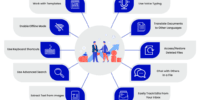How to Implement a Big Data Strategy for Data-Driven Insights

This article aims to provide a comprehensive guide on implementing a big data strategy for data-driven insights.
It explores the significance of a well-defined big data strategy and emphasizes the importance of aligning goals and objectives with data-driven insights.
The article further discusses the process of identifying and collecting relevant data sources, implementing appropriate data storage and processing infrastructure, and analyzing and extracting insights from big data.
Additionally, it highlights the significance of building data visualization and reporting capabilities, as well as the need for monitoring and iterating the big data strategy.
Key Takeaways
- Implementing a well-defined big data strategy is essential for leveraging the power of analytics and making data-driven decisions.
- Setting clear objectives provides a framework for decision-making and defines desired outcomes.
- Measuring the success of data-driven initiatives determines their effectiveness and value.
- Robust data encryption techniques and access controls are essential to protect sensitive information from unauthorized access.
Understanding the Importance of Big Data Strategy
The importance of a well-defined big data strategy lies in its ability to enable organizations to harness large volumes of data for generating valuable insights and making data-driven decisions.
Analytics plays a crucial role in this process as it helps organizations extract meaningful information from the vast amount of data they collect. By applying analytical techniques to big data, organizations can identify patterns, trends, and correlations that may not be apparent through traditional data analysis methods. This enables them to gain a deeper understanding of their customers, operations, and market dynamics.
Data-driven decision making, on the other hand, involves using data and analytics to guide and support decision-making processes. By basing decisions on data-driven insights, organizations can mitigate risks, optimize resources, and improve overall performance.
Implementing a well-defined big data strategy, therefore, is essential for organizations to leverage the power of analytics and make data-driven decisions.
Defining the Goals and Objectives of Your Data-driven Insights
This discussion aims to explore the importance of setting clear objectives, measuring data-driven success, and aligning goals with insights in the context of data-driven insights.
Setting clear objectives is crucial as it provides a framework for decision-making and helps in defining the desired outcomes.
Measuring data-driven success allows organizations to assess the effectiveness of their strategies and make informed decisions based on objective evidence.
Additionally, aligning goals with insights ensures that the organization’s objectives are in line with the valuable insights derived from data analysis, maximizing the potential benefits of data-driven decision-making.
Setting Clear Objectives
Setting clear objectives is essential when implementing a big data strategy for data-driven insights.
Setting objectives provides a clear direction and purpose for the data analysis process. It allows organizations to focus their efforts on specific goals and outcomes.
When setting objectives, it is important to ensure they are measurable, as this enables progress to be tracked and evaluated. Measuring progress allows organizations to determine whether they are on track to achieve their desired outcomes and make any necessary adjustments to their strategy.
Measuring Data-Driven Success
Measuring the success of data-driven initiatives is crucial in determining the effectiveness and value of the implemented strategies. To assess the impact of data-driven initiatives, organizations need to establish a framework for tracking metrics. These metrics should align with the objectives set during the strategy development phase.
By tracking these metrics, organizations can evaluate the extent to which they are achieving their goals and identify areas for improvement. Key metrics to consider include data quality, data accessibility, data utilization, and business outcomes.
Data quality metrics assess the accuracy, completeness, and relevance of the data being used. Data accessibility metrics measure the ease of access to data for decision-making purposes. Data utilization metrics evaluate the extent to which the data is being used to inform decision-making processes. Lastly, business outcome metrics assess the impact of data-driven initiatives on key performance indicators.
Aligning Goals With Insights
Aligning organizational goals with insights derived from data analysis is essential for maximizing the value and effectiveness of data-driven initiatives. When organizations align their goals with the insights obtained from data analysis, they can ensure that their actions and decisions are driven by evidence-based insights.
This alignment helps in identifying areas where data-driven insights can create the most impact and contribute to achieving organizational objectives. By aligning goals with data-driven insights, organizations can prioritize their resources and efforts towards the most valuable opportunities.
Moreover, this alignment enables organizations to measure the success of their data-driven initiatives accurately. It allows them to track progress, identify areas for improvement, and make informed decisions based on the insights gained from data analysis.
Overall, aligning goals with data-driven insights is crucial for organizations to leverage the full potential of their data and drive meaningful outcomes.
Identifying and Collecting Relevant Data Sources
Identifying and collecting relevant data sources requires a thorough analysis of various databases, repositories, and external sources to ensure comprehensive coverage. This process is crucial for effective data quality management and overcoming data integration challenges.
Data quality management involves assessing the accuracy, completeness, consistency, and reliability of the collected data. It requires implementing measures to ensure data accuracy, such as data validation and cleansing techniques.
Additionally, data integration challenges arise due to the heterogeneity and complexity of data sources. These challenges include schema and format differences, data inconsistency, and data duplication. Overcoming these challenges requires a robust data integration strategy that includes data mapping, transformation, and consolidation.
Implementing Data Storage and Processing Infrastructure
This discussion will explore three key points related to implementing data storage and processing infrastructure:
- Cloud Vs On-Premise: This point examines the advantages and disadvantages of utilizing cloud-based solutions versus on-premise infrastructure for data storage and processing.
- Scalability and Performance: This point delves into the considerations and challenges associated with scaling data storage and processing systems to meet the growing demands of big data.
- Data Security Measures: This point addresses the importance of implementing robust security measures to protect sensitive data stored and processed within an infrastructure.
Cloud Vs On-Premise
When comparing the options of cloud-based and on-premise solutions, it is important to consider the specific needs and requirements of the organization. One of the key factors that organizations need to evaluate is the cost comparison between cloud adoption and on-premise solutions. Here are some points to consider:
- Cloud-based solutions often have lower upfront costs as there is no need to invest in hardware infrastructure.
- On-premise solutions may require significant capital expenditure for hardware and software licenses.
- Cloud solutions offer scalability and flexibility, allowing organizations to easily adjust resources based on their needs.
- On-premise solutions give organizations complete control over their data and infrastructure, which may be crucial for certain industries.
Considering these factors, organizations should carefully assess their budget, data security requirements, and long-term scalability goals before deciding between cloud-based and on-premise solutions.
Scalability and Performance
Scalability and performance are important factors to consider when evaluating the suitability of cloud-based and on-premise solutions for an organization.
Scalability challenges arise when dealing with large volumes of data, as the system needs to be able to handle increasing data loads without compromising performance. On-premise solutions may face limitations in terms of hardware capacity and infrastructure, making it difficult to scale as data grows.
Cloud-based solutions offer the advantage of scalability, as they can easily scale up or down based on demand. However, performance optimization is crucial to ensure that the system operates efficiently and delivers results in a timely manner.
Techniques such as data partitioning, parallel processing, and caching can be employed to optimize performance and enhance the overall efficiency of the system.
Data Security Measures?
Data security measures are essential in both cloud-based and on-premise solutions to protect sensitive information from unauthorized access and ensure the integrity and confidentiality of the data.
To effectively secure data, organizations must implement robust data encryption techniques. Encryption transforms data into a coded format, making it unreadable to unauthorized individuals.
Access controls play a crucial role in data security by limiting access to authorized users only. Implementing strong access controls ensures that only authorized individuals can view, modify, or delete sensitive data.
Additionally, organizations should regularly update their security measures to address emerging threats and vulnerabilities. Regular security audits and assessments can help identify potential weaknesses and enable proactive measures to prevent data breaches.
Analyzing and Extracting Insights From Big Data
Upon analyzing and extracting insights from big data, valuable information can be obtained to inform decision-making processes. This involves employing various data cleaning techniques to ensure the accuracy and reliability of the data. Data cleaning involves identifying and correcting errors, inconsistencies, and inaccuracies within the dataset. This process helps to enhance the quality of the data and improve the validity of the insights derived from it.
Additionally, predictive analytics plays a crucial role in extracting insights from big data. By using statistical algorithms and machine learning techniques, predictive analytics can identify patterns, trends, and correlations within the data. These insights can then be used to make informed predictions and forecasts, enabling organizations to make data-driven decisions.
| Data Cleaning Techniques | Predictive Analytics |
|---|---|
| Data profiling | Regression analysis |
| Data standardization | Decision trees |
| Deduplication | Neural networks |
| Outlier detection | Time series analysis |
| Missing data imputation | Clustering |
Building Data Visualization and Reporting Capabilities
and take appropriate actions
Overall, data visualization techniques and reporting tools are essential for effectively communicating insights derived from big data. By using visual representations, complex data can be simplified and made more accessible to a wider audience. Data visualization techniques allow for the identification of patterns, trends, and anomalies within large datasets, helping to uncover valuable insights that might otherwise be overlooked.
Reporting tools and techniques enable the creation of comprehensive and interactive reports, which can be customized to meet the specific needs of stakeholders. These reports provide a clear and concise summary of the data analysis process, findings, and recommendations, helping decision-makers understand the implications of the data and take appropriate actions.
Monitoring and Iterating Your Big Data Strategy
One key aspect of effectively managing and optimizing organizational data initiatives involves continuously monitoring and refining the approach taken. This requires iterative improvements and real-time monitoring to ensure that the big data strategy is on track and aligned with the organization’s goals and objectives.
Iterative improvements involve regularly reviewing and analyzing the data to identify any areas for enhancement or modification. This allows for a more agile approach, where adjustments can be made based on real-time insights and feedback.
Real-time monitoring, on the other hand, enables organizations to track the performance and effectiveness of their big data strategy in real-time, allowing for quick identification of any issues or bottlenecks that may arise.
Frequently Asked Questions
What Are the Potential Challenges and Roadblocks That Organizations Commonly Face When Implementing a Big Data Strategy?
Potential challenges and roadblocks commonly faced by organizations when implementing a big data strategy include data quality issues, lack of skilled personnel, technological infrastructure limitations, privacy and security concerns, and the need for cultural and organizational change.
How Can Organizations Ensure the Quality and Accuracy of the Data Collected for Their Data-Driven Insights?
Ensuring data integrity and managing data quality are essential for organizations to derive accurate and reliable insights. This involves implementing robust data governance frameworks, conducting regular data audits, employing data validation techniques, and leveraging appropriate data management tools.
What Are Some Best Practices for Maintaining the Security and Privacy of Big Data Throughout Its Lifecycle?
Data governance is essential for maintaining the security and privacy of big data throughout its lifecycle. Implementing robust data encryption techniques can further enhance the protection of sensitive information.
How Can Companies Effectively Leverage Artificial Intelligence and Machine Learning Technologies to Extract Valuable Insights From Their Big Data?
Artificial intelligence applications and machine learning algorithms can effectively leverage big data to extract valuable insights. By utilizing advanced analytical techniques, companies can uncover patterns, trends, and correlations that lead to data-driven decision making and improved business outcomes.
What Are the Key Considerations for Scaling and Expanding a Big Data Strategy as the Organization Grows and Evolves?
Scaling considerations and evolving strategies are key factors to consider when expanding a big data strategy as an organization grows. These factors ensure that the strategy remains effective and adaptable to changing needs and technological advancements.








